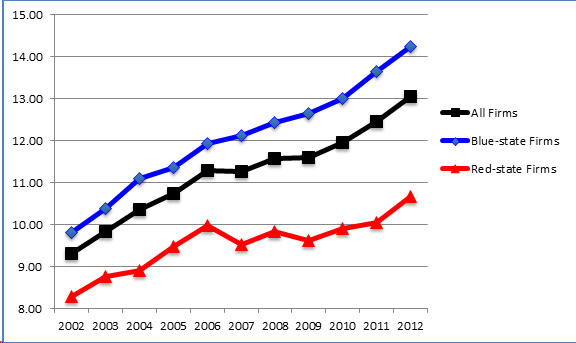Our study examines whether gender disparity exists disproportionately along the conservative and liberal geographical division. We investigate whether female board representation depends on the location of company headquarters in “red” states (which tend to vote for Republican candidates) or in “blue” states (which tend to vote for Democratic candidates). The investigation focuses on director composition between 2002 and 2012, based on board of director data for the S&P 1500 companies. We delineate red or blue companies based on how their home state voted in the past four presidential elections between 2000 and 2012, which coincides with our sample period, or the margin of votes cast for Republican or Democratic presidential candidates in these four elections.
We find that female board representation is consistently lower in “red companies” (firms headquartered in red states) than in “blue companies” (firms headquartered in blue states). Figure 1 summarizes our findings by plotting the mean percentage of female directors during 2002–2012 delineated by red and blue companies. In 2012, only 10.6% of directors in red companies are women, compared to 14.2% of board membership of blue companies in the same year.
In a multivariate analysis, we control for major determinants of female board representation including industry effects, firm size, time trends, and female economic participation. Our results confirm that during 2002–2012, female representation in red companies is lower by 2.84% than that in blue companies. Since the mean female board membership in red companies is 9.56% during 2002–2012, the difference implies that women hold roughly 30% more board positions in blue companies than in red companies.
It is difficult to link labor immobility or state-level variations in women’s human capital accumulation to corporate female director hiring, because directors are not required to reside in the state where the company’s headquarter is located. Even so, our principal finding that female board representation is lower in red than blue companies holds after controlling for state-level female labor supply.
Discrimination against women could explain our finding. While “hostile sexism” is unlikely, we cannot rule out the existence of a subtle form of gender screening, consistent with “benevolent sexism” (Glick and Fiske 1996) in social psychology, or “implicit” discrimination (Bertrand, Chugh, and Mullanathan 2005) in economics. One explanation is that a varying degree of gender preferences manifests as a difference in director hiring practices between the red and blue companies.
We also compare the compensation of female and male directors. We find that the average female director compensation is lower than that of the male counterpart by 2.48% ($4,650) in blue companies and by 3.94% ($7,080) in red companies, where male-female director pairs are matched on committee membership and tenure within the same company. Such a male-female compensation gap is statistically significant at the one percent level for both blue companies and red companies. However, the difference in the male-female compensation gap between blue companies and red companies is not statically significant at conventional levels. These findings, combined with the evidence of significantly lower female representation in red company boards, suggest that discrimination against women, if it exists, manifests as a lower level of employment rather than as lower compensation.
In summary, this study offers the first systematic evidence of a difference in opportunities for women to serve on corporate boards based on the division between conservative and liberal norms. The evidence also informs the ongoing debate about the gender gap in the boardroom and approaches towards improving the low female board membership. If the policy objective is to encourage greater female representation on the board, then policy makers are encouraged to examine whether any gender bias exists in boardrooms based on social or political factors. Red companies can also consider devoting greater resources to recruiting talented female directors or to improving the appeal of the board for female candidates.
The preceding post comes to us from Ying Compton, Assistant Professor, George Washington University – School of Business, Sok-Hyon Kang, Professor, George Washington University – School of Business and Zinan Zhu, Assistant Professor, National University of Singapore. The post is based on their recent article, which is entitled “Red vs. Blue: Does Female Board Membership Depend on Whether the Company is Located in Conservative or Liberal States?” and available here.
 Sky Blog
Sky Blog

